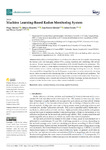Machine Learning-Based Radon Monitoring System

Use this link to cite
http://hdl.handle.net/2183/31186Collections
- Investigación (FIC) [1684]
Metadata
Show full item recordTitle
Machine Learning-Based Radon Monitoring SystemDate
2022Citation
Valcarce, D.; Alvarellos, A.; Rabuñal, J.R.; Dorado, J.; Gestal, M. Machine Learning-Based Radon Monitoring System. Chemosensors 2022, 10, 239. https://doi.org/10.3390/chemosensors10070239
Abstract
[Abstract] Radon (Rn) is a biological threat to cells due to its radioactivity. It is capable of penetrating the human body and damaging cellular DNA, causing mutations and interfering with cellular dynamics. Human exposure to high concentrations of Rn should, therefore, be minimized. The concentration of radon in a room depends on numerous factors, such as room temperature, humidity level, existence of air currents, natural grounds of the buildings, building structure, etc. It is not always possible to change these factors. In this paper we propose a corrective measure for reducing indoor radon concentrations by introducing clean air into the room through forced ventilation. This cannot be maintained continuously because it generates excessive noise (and costs). Therefore, a system for predicting radon concentrations based on Machine Learning has been developed. Its output activates the fan control system when certain thresholds are reached.
Keywords
Radon
Machine learning
Monitoring
Applied biosensing
Machine learning
Monitoring
Applied biosensing
Editor version
Rights
Atribución 4.0 Internacional






